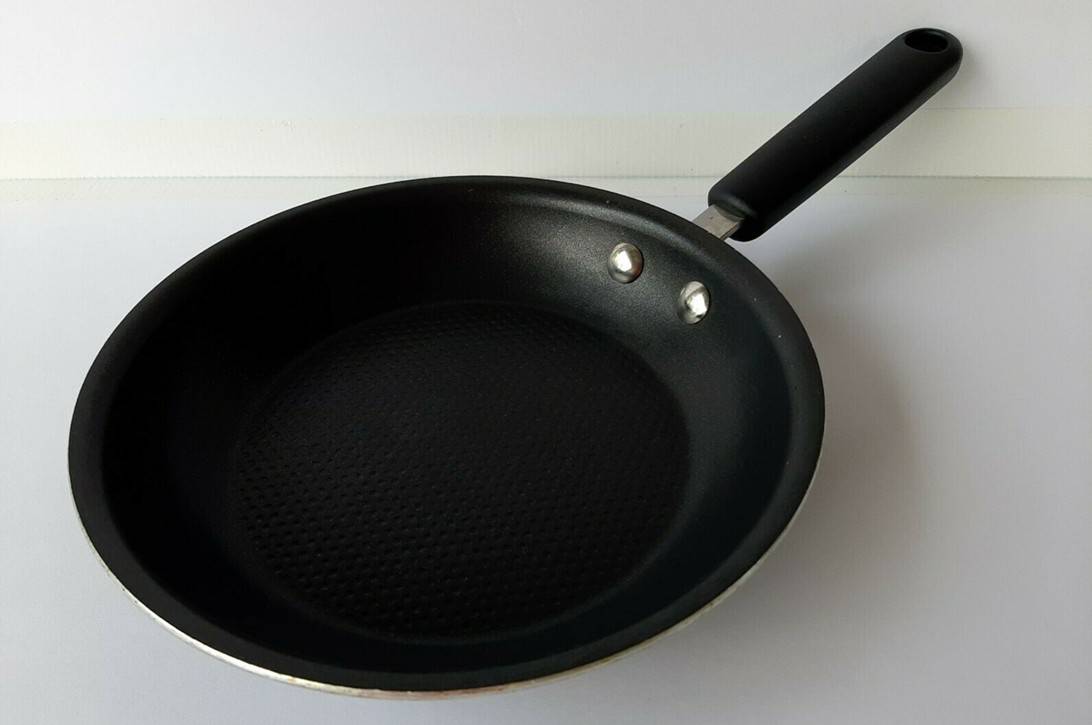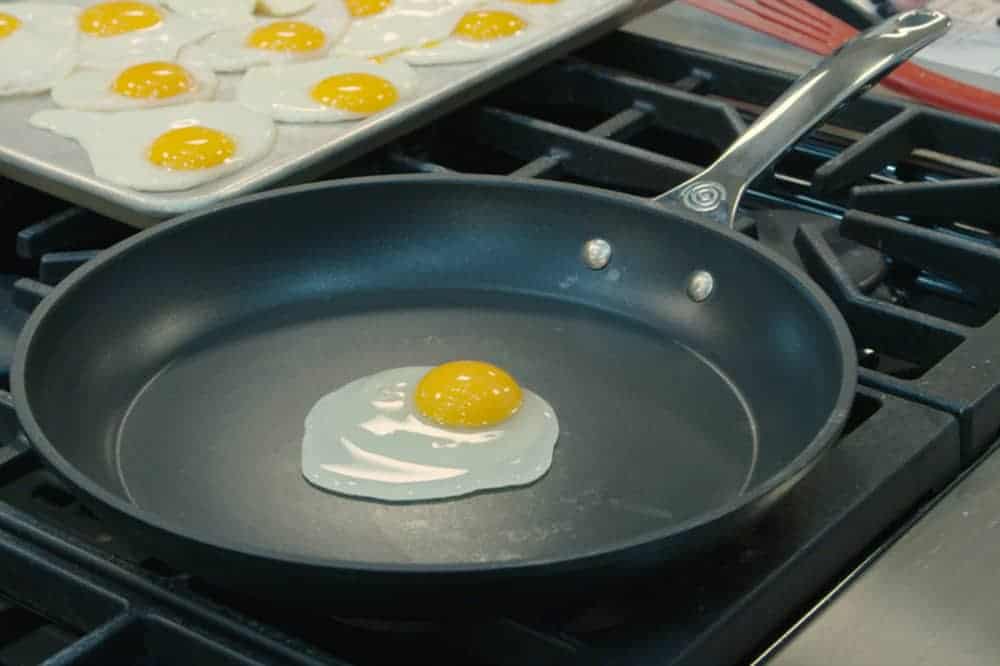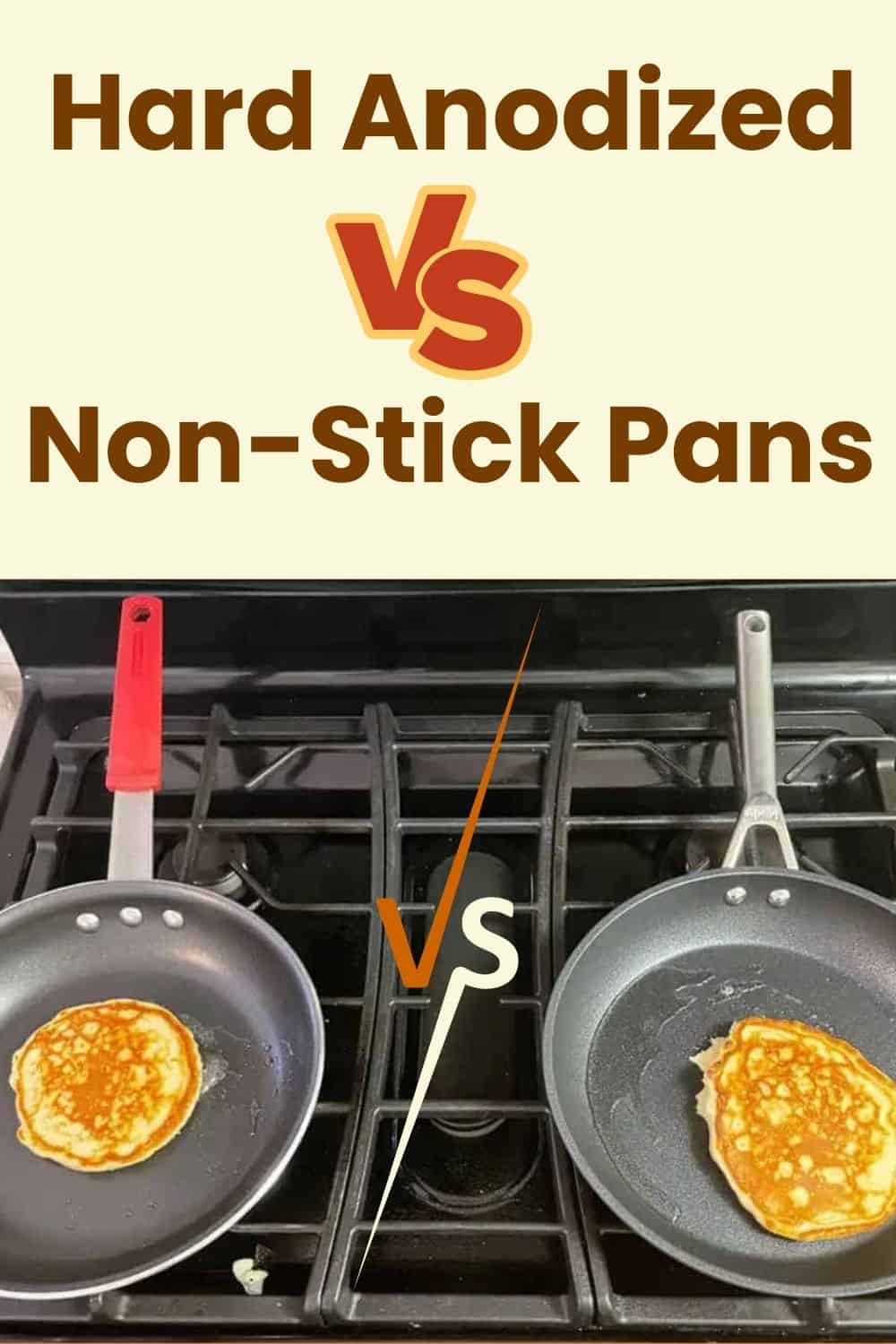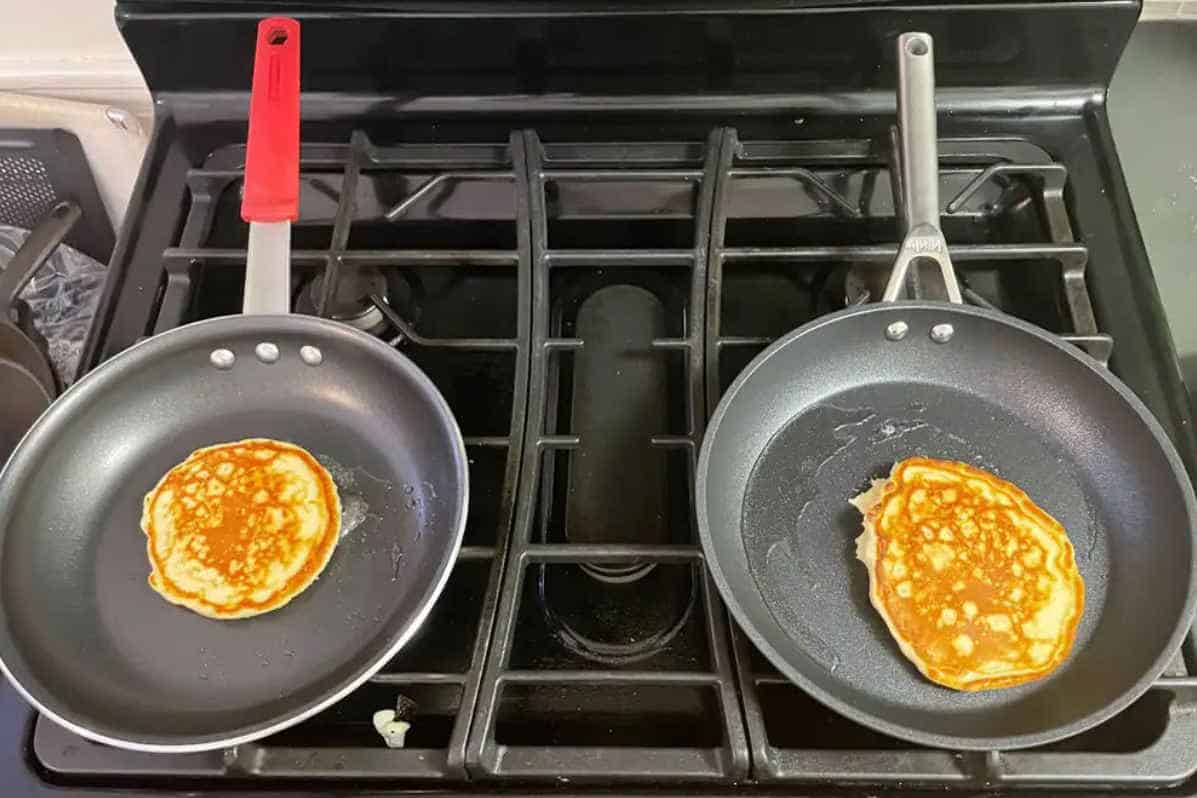The right cookware enhances the cooking process, experience, and dish quality. You will find several types of cookware at the store. It makes you confused about which one to choose.
Let’s shorten the list of choices. We will focus on the two most popular types, hard anodized and non-stick pans.
Both cookware may use copper, stainless steel, or aluminum as base material. But what makes them different? Their manufacturing process. Each process gives them distinct properties.
Some find this distinction easier to remember:
“Most hard-anodized cookware has non-stick properties. But not all non-stick cookware is hard-anodized.”
Let’s make it clear. It is still confusing, right?
| Hard-Anodized Pans | Non-Stick Pans | |
| Materials | Aluminum alloy | Aluminum or stainless steel with non-stick coating |
| Surface | Hard and durable | Coated with PTFE (polytetrafluoroethylene) |
| Non-Stick | Limited | Excellent |
| Heat Conductivity | Excellent heat distribution | Good heat conductivity |
| Durability | Highly durable; resistant to scratches | Coating wears off over time |
| Versatility | Suitable for wide range of cooking methods | Suitable for low-fat cooking and delicate foods |
| Cooking Oil | Requires more oil/butter | Requires minimal oil/butter |
| Maintenance | May require scrubbing | Easy to clean, food slides off effortlessly |
| Price | Moderately priced | Varies on brand and quality |
Knowing About Hard Anodized Pans

Hard anodized pans have an aluminum base that makes them lightweight. This makes the pans easier to maneuver while cooking. Besides, its aluminum base also provides cookware with excellent heat conductivity.
What sets them apart from conventional aluminum cookware is their manufacturing process. This cookware undergoes the anodization process. The process makes it more durable and non-reactive.
Even with daily use, you won’t have to worry about abrasions and corrosion. The cooking surface is still non-reactive even when you cook at high temperatures. Being non-reactive eliminates your worries about chemicals leaching onto your dishes.
Not all, but some hard anodized cookware has a non-stick coating. You can flip ingredients or cook delicate recipes without worries.
Benefits of Using Hard Anodized Pans
Hard Anodized Pans have a longer lifespan. They can last over ten years if you maintain them properly.
- Excellent heat distribution and retention. You can rely on its heating properties to maintain a consistent temperature.
- You can cook any recipe on its non-reactive surface. Its surface will not react with any ingredients, preserving the quality of your dish. There’s no need to worry about chemical leaching too.
- Those with non-stick coating are easier to clean and maintain. Its slippery surface prevents any food residue and makes washing easier.
These benefits show how these pans make our cooking experience enjoyable from start to finish. Yet, it is not all sunshine. Hard anodized pans have their disadvantages.
Drawbacks of Using Hard Anodized Pans
Hard anodized has a few disadvantages you have to ponder about.
- It is more expensive than non-stick and basic aluminum cookware. The anodization process makes the costs of the cookware expensive. However, this may not be a drawback if their durability offsets the expense. You can save in the long run and refrain from replacing them very often.
- Hard anodized pans need cleaning and maintenance to prolong their lifespan. Although they can resist scratches and abrasions, only use silicone, wooden, or non-metallic utensils when cooking. When cleaning, do not use scouring pads or abrasive cleaners.
These downsides are relatively minor than the benefits. You can prevent them by knowing how to use and care for the pans.
Understanding Non-Stick Pans

Most non-stick pans use aluminum or stainless steel material for their base. Its cooking surface has a polytetrafluoroethylene (PTFE) coating, making it non-stick and slippery. Besides its durability and heat conductivity, food does not stick to the cookware. So, when cooking or washing the cookware, you do not have to worry about residues left. You can cook with minimal butter or oil and flip, toss, and remove the food without any worries.
However, PTFE coating has a downside. It may harm our health and the environment. To attract more consumers, manufacturers introduced ceramic-based non-stick coatings—safer and more eco-friendly than PTFE.
Benefits of Using Non-Stick Pans
Home cooks and professional chefs prefer non-stick cookware because of their benefits.
- Its non-stick coating can prevent food residues from clinging to its surface. You can quickly flip, stir, and remove the food without leaving residues behind. Leaving no residue makes washing the cookware easier.
- You only have to use minimal butter or oil to achieve the same browning and flavor of dishes. Non-stick pans allow you to cook with less fat. This allows for healthier cooking methods. This is your best choice if you are conscious of your fat intake.
- Suitable cookware for cooking delicate foods. The non-stick surface is a great help if your recipe needs gentle handling. It prevents food from sticking on the surface, allowing easier flipping and serving. “Non-stick pans help ensure delicate recipes don’t break apart or lose their shape.
- It has excellent heat distribution properties. The heat is evenly distributed across its cooking surface. You do not have to worry about inconsistent cooking temperatures and hot spots.
It shares many benefits with hard anodized cookware. But what sets them apart is the affordability of non-stick pans. This affordability makes non-stick pans more accessible to consumers
Drawbacks of Using Non-Stick Pans

Regardless of its benefits, non-stick pans have disadvantages that you need to consider.
- Non-stick coating is susceptible to scratches and wearing over time. Do not use metal utensils or harsh cleaning tools for non-stick pans. Scratches may remove the non-stick properties and expose its base material. It can affect the performance of the pan.
- Non-stick pans cannot withstand high-heating cooking methods. You cannot sear, broil, or bake at high temperatures. If you exceed its limit, non-stick coating will degrade and release harmful fumes. You need to note which cookware is suitable for your stove type.
- High risk of toxic chemicals leaking. The non-stick coating has a temperature threshold. If the heat temperature goes above 500°F (260°C), the non-stick coating can release poisonous fumes. These fumes are harmful when inhaled. Always follow the temperature limits and ensure proper ventilation when cooking.
- Limited lifespan. The non-stick coating on pans wears off with regular use and countless cleaning. If it loses its non-stick properties, you must replace the cookware or bring it for re-coating.
- Coating degrades with harsh cleaning. Do not use any abrasive cleaners or scouring pads. These products damage the non-stick coating surface of your pans. You must read the cleaning instructions to help maintain its non-stick layer.
Even with these drawbacks, they are still helpful for several cooking styles.
Why are Consumers Confused Between the Two?
Consumers often get confused between these two types of cookware due to their similarities. As they need help deciding, some marketing claims influence more to their doubts.
The confusion started in the 1960s. Both cookware were famous for their heat-conduction properties. However, the hard anodized cookware had no non-stick coating, which became a deal-breaker.
People often prefer pans with non-stick coatings over hard-anodized ones.
Manufacturers stepped up and added a coat to the cookware, stopping the production of old models. And now, people choose hard anodized cookware more.
Consumers who need to be more informed about this still need clarification on the two. Look closely at how hard anodized is better than other non-stick pans.
Comparing Hard Anodized Cookware to Other Non-Stick Cookware
We all know hard anodized cookware has a non-sticking feature. But what makes it different?
Let’s figure it out.
Hard Anodized vs. Aluminum Non-stick
Both cookware have an aluminum base. But comparing the two, hard anodized is more competent. Its anodization makes it non-reactive and resistant to corrosion, rust, and warp.
If the non-stick coating wears off, the hard anodized pan still provides a durable cooking surface. It makes you feel safer when cooking in a specific style.
Hard Anodized vs. Stainless Steel Non-Stick
The anodized aluminum base is more efficient in heat conduction. It heats the cookware faster, spreads even, and retains heat more efficiently.
On the other hand, the stainless steel non-stick pan has one upper hand. Its compatibility with induction stoves. Induction stove tops require cookware with a magnetic bottom, which stainless steel has.
Hard Anodized vs. Ceramic Non-Stick
It is a non-stick cookware that uses ceramic coating instead of PTFE. People prefer ceramic coating as it is considered safer for health and the environment.
Ceramic cookware can have a base of standard aluminum, stainless steel, or hard anodized aluminum. Hence, its feature depends on the base material it has.
Conclusion: Which Cookware to Choose?
Looking at how similar they are, it is understandable why consumers get confused.
Hard anodized and non-stick pans have similar features. But despite their similarities, they have drawbacks that break the deal. Your choice depends on your cooking needs and preferences.
Select the cookware that best suits your cooking needs and preferences.


Michael Johnson is the founder of Pan Mastery, Inspired by his blacksmith grandfather’s legacy has a deep appreciation for hand-crafted pots and pans, he provides invaluable guides, reviews, and recipes to enhance your culinary journey.

